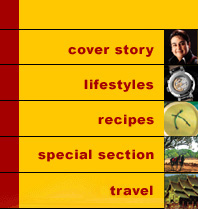
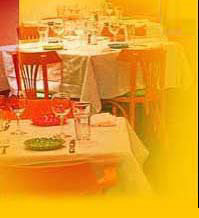

The Hills Are Alive With The Sound Of Music Toy trains chugging, birds chirping, horses neighing, monkeys chattering, children playing, people laughing says Farzana Contractor. Matheran is the closest hill station of Bombay, just 95 kms away. In fact, it is even accessible on the local train line, on Central Railway. All one has to do is board a suburban train at VT (Victoria Terminus or Chatrapati Shivaji Terminus) and get off at Neral, the base of the hill . Once at Neral, you could hire a taxi or catch a mini-train going up which until recently was run on a steam engine. The toy train is Matheran�s mainstay. There is an old world charm about riding up from Neral to Matheran in this train. The ride up the hillside past dense forests, grassy hillsides, vertical cliffs is a pleasant experience. It was Sir Adamjee Peerbhoy who founded the railway way back in 1907. He put his dream of a railway above everything else in his life, in 1901 he had spent Rs. 16 lakh to establish it. The Neral-Matheran toy train runs on the 21-kilometer tracks laid by the great Indian Peninsula Railway, India�s first railway company, today known as Central Railways. In recent times three crores have been spent on its restoration. It�s an 8 km, uphill winding road, steep and tricky in parts, the cliff on one side the valley on the other. Time to time the tiny train tracks cross paths with road. Very charming. As you chug or climb up you see how dense it gets. Mr. Hugh Poyntz Mallet, the British Collector of Thana District in 1850 who discovered, or at least explored this hill station did a pretty good job of greening the surroundings. The drive up takes less than 20 minutes (the mini-train takes a lot longer, over two hours) and you reach a junction where you have no choice but to park your car and leave it there for the next few days that you might wish to remain tucked up there in splendid bliss. Every once in a while there will be a batch of people who will activate the agenda of making Matheran car friendly and then the opponents who will shoo down the idea. A bit shorter walk to the bazaar if you want to avoid the crowds is to walk on the railway line. A lot of locals do that, stepping on the fish plates as they go along, stopping for some limbu-pani at a halfway point, feeding the many monkeys on the way. The mode of transportation predominantly is on horse back. Charges, anywhere between Rs. 75 to 200 an hour. Depending if it is high season or low, the horse is a puny one or a stud, you look rich or richer! In any case, it must be the cheapest rent for such a luxury, as compared to anywhere in India. And riding to the various points is a treat. In recent times many fancy hotels have opened shop. Not known names, or those belonging to a chain of hotels, but fairly posh ones. In addition to these are ordinary places where the atmosphere is homely and so tariffs low. But by far the nicest place would be Lord�s and The Verandah In The Forest. Which brings me to the private cottages and rest houses, ancient bungalows and homes. Long ago it was the foreigners, mainly British who frequented this and other hill stations of Maharashtra, followed by Parsis. Which is why you often come across a lot of old properties standing in Parsi names. The lush green solitary woodland of Matheran can best be described as a simple, rustic, forgotten mountain abode. Matheran means �mother forest� and it is just that. Even today the oldest tribesmen not only live there by the mountain sides, but continue to earn their livelihood in much the same ways. There are no great schools in Matheran, unlike Panchgani. Apart from St. Xavier�s, there is just another government, marathi medium school. But there is a small race-course where the more enthusiastic ones go to learn riding and a lake, called Charlotte, which dries up by summer time. It is Matheran�s main reservoir for drinking water. Like all hill stations in our country there are a whole lot of �points� that we go to, to take in the view, never mind if the views from all these points are not too different. The three other points worth mentioning are Ram Baug Point from where you can see Khandala and Karjat, Chowk Point Matheran beckons in this season, when the heat has dispersed, the mud has settled down and the rains have created innumerable waterfalls. The crowds are at bay, and the hotels have slashed their rates. Go, and take your dog with you. There must be hotels which will allow them in during off season! PHOTOGRAPHS BY FARZANA CONTRACTOR | |
|
|

Home Page
About the mag
Subscribe
Advertise
Contact Us

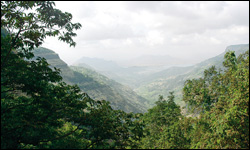
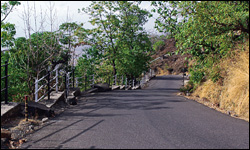 A fast train would take about two and a half hours. If you drove early morning from Bombay to Matheran you would do it in just one and a half hour!
A fast train would take about two and a half hours. If you drove early morning from Bombay to Matheran you would do it in just one and a half hour!
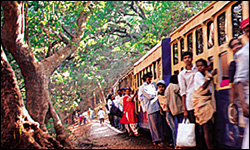 He travelled all the way to Germany for engines. Oriensten & Kopple designed four engines especially for the train, numbered 738, 739, 740 and 741. While the last three are housed in Matheran Station, Linton Buzzard of London and National Railway Museum respectively, no one seems to know where the first one is lying and in what condition.
He travelled all the way to Germany for engines. Oriensten & Kopple designed four engines especially for the train, numbered 738, 739, 740 and 741. While the last three are housed in Matheran Station, Linton Buzzard of London and National Railway Museum respectively, no one seems to know where the first one is lying and in what condition.
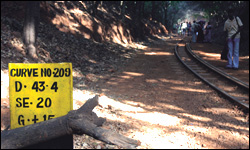 Presently two daily trains are operational for the to-and-fro journey from Neral to Matheran.
Presently two daily trains are operational for the to-and-fro journey from Neral to Matheran.
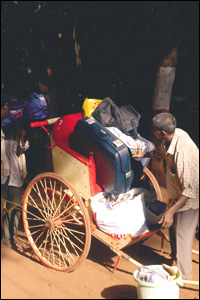 Cars are not allowed beyond Dasturi Naka. And there is no way you can sneak it in either. You get off, buy a hill station tax ticket, walk up some steps, and into a walking track. Three kilometers to the main street, which is M.G. Road and which is known as the bazaar. It is an active track all along since that�s the only way into Matheran. So all and sundry use it. Tourists, locals, tribesmen, villagers. Horsemen, rickshaw-pullers, hoteliers, restaurateurs, holiday homes and bungalow owners. It�s also the route to bring in all the provisions that are needed to make life comfortable. So you find trails of donkeys, poor chaps, lugging loads of commodities, marching in one behind the other.
Cars are not allowed beyond Dasturi Naka. And there is no way you can sneak it in either. You get off, buy a hill station tax ticket, walk up some steps, and into a walking track. Three kilometers to the main street, which is M.G. Road and which is known as the bazaar. It is an active track all along since that�s the only way into Matheran. So all and sundry use it. Tourists, locals, tribesmen, villagers. Horsemen, rickshaw-pullers, hoteliers, restaurateurs, holiday homes and bungalow owners. It�s also the route to bring in all the provisions that are needed to make life comfortable. So you find trails of donkeys, poor chaps, lugging loads of commodities, marching in one behind the other.
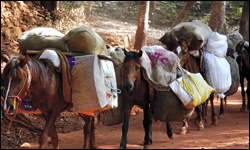 Those who have done so much to protect the ecology of the place are the late Jimmy Lord and Mrs Zenobia Lord. Mr. Lord used to live in Matheran till he died in 2001 and Mrs. Lord in Bombay. And both were frequent visitors at Afternoon House, the head office of the newspaper, Afternoon Despatch and Courier, where the founder editor, Behram Contractor championed their cause. Thankfully till this date the lobbyists demanding a motorable road into the hill station have not succeeded even in tarring or cobbling the walking track, for surely that�s not the best for the 500-odd horses who canter up and down this path many times a day.
Those who have done so much to protect the ecology of the place are the late Jimmy Lord and Mrs Zenobia Lord. Mr. Lord used to live in Matheran till he died in 2001 and Mrs. Lord in Bombay. And both were frequent visitors at Afternoon House, the head office of the newspaper, Afternoon Despatch and Courier, where the founder editor, Behram Contractor championed their cause. Thankfully till this date the lobbyists demanding a motorable road into the hill station have not succeeded even in tarring or cobbling the walking track, for surely that�s not the best for the 500-odd horses who canter up and down this path many times a day.
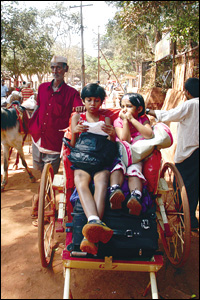 As soon as you reach the end of this track, you are in the centre of town.
As soon as you reach the end of this track, you are in the centre of town.
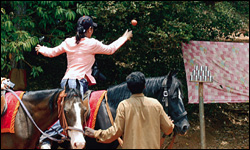 My husband�s extended family for example, had their horses kept there all year round. And they would go there weekends, for a spot of riding. In summer for some reason, perhaps overcrowding, the horses would be shifted to Mahableshwar and they would then spend time there. These properties you see tucked around in the heavily wooded areas are rather beautiful. Malet�s bungalow was called The Byke, and there is a hotel by that name, perhaps the house still stands, I am afraid I forgot to enquire. Barr House which belonged to the Dubashes, a well-known Parsi family of Bombay is a good example of the old stately houses. The Shapoorji Mansion, another. Munira Chudasama and Naaz and Remu Jhaveri are also among those in Bombay who have wonderful getaways in Matheran.
My husband�s extended family for example, had their horses kept there all year round. And they would go there weekends, for a spot of riding. In summer for some reason, perhaps overcrowding, the horses would be shifted to Mahableshwar and they would then spend time there. These properties you see tucked around in the heavily wooded areas are rather beautiful. Malet�s bungalow was called The Byke, and there is a hotel by that name, perhaps the house still stands, I am afraid I forgot to enquire. Barr House which belonged to the Dubashes, a well-known Parsi family of Bombay is a good example of the old stately houses. The Shapoorji Mansion, another. Munira Chudasama and Naaz and Remu Jhaveri are also among those in Bombay who have wonderful getaways in Matheran.
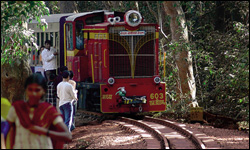 The red mud is what gives the place its character, as also the horses, and the bazaar, which is the hub of activity.
The red mud is what gives the place its character, as also the horses, and the bazaar, which is the hub of activity.
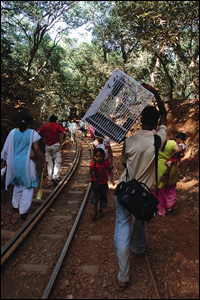 Matheran too has many. 33 to be exact. For walkers it will be a paradise to follow these trails, but alternatively you could bargain with the horse-walla for a package deal. Remember, always work out the charges first, you don�t want altercations later on. Panorama Point 5 kms to the north of town commands an outstanding view of the Sayadri Range and overlooks the town of Neral. If you get lucky you may see the toy train as it rounds the curve just below. It�s an old world sight alright. Nearby is Mount Barry and between the two is Garbut Point, my favourite, for no reason except that on my first family visit to Matheran when I was still in school, that was where we all rode to.
Matheran too has many. 33 to be exact. For walkers it will be a paradise to follow these trails, but alternatively you could bargain with the horse-walla for a package deal. Remember, always work out the charges first, you don�t want altercations later on. Panorama Point 5 kms to the north of town commands an outstanding view of the Sayadri Range and overlooks the town of Neral. If you get lucky you may see the toy train as it rounds the curve just below. It�s an old world sight alright. Nearby is Mount Barry and between the two is Garbut Point, my favourite, for no reason except that on my first family visit to Matheran when I was still in school, that was where we all rode to.
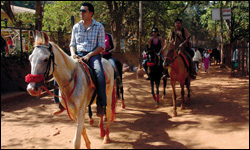 which offers stunning views of Karnala and Prabal Forts as well as Panvel, and the Hart Point from where you can see Bombay by night.
which offers stunning views of Karnala and Prabal Forts as well as Panvel, and the Hart Point from where you can see Bombay by night.